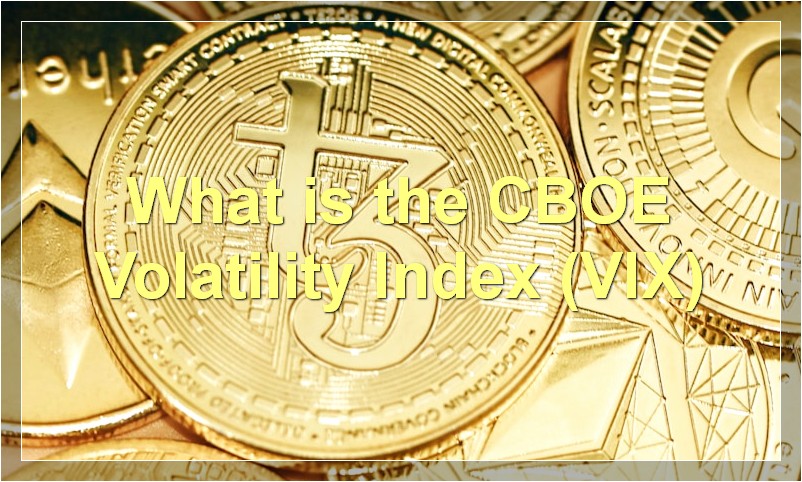Many investors use historical volatility to help predict future stock prices, but few know how to calculate it. By understanding how to calculate historical volatility, investors can make more informed decisions about which stocks to buy and sell.
How is historical volatility calculated

Volatility is a measure of how much the price of a security, such as a stock or commodity, fluctuates over time. It is calculated by taking the standard deviation of the security’s price over a certain period of time, usually 20 or 21 trading days.
Historical volatility can be useful for traders in two ways. First, it can help them assess how volatile a security has been in the past and whether it is likely to be volatile in the future. Second, it can help them identify opportunities to buy or sell a security when its price is deviating from its historical norm.
For example, if a trader sees that a stock’s historical volatility is 30% and the current price is 10% below the stock’s average price over the past year, the trader may believe that the stock is underpriced and expect it to rise back to its historical average. Conversely, if the current price is 10% above the historical average, the trader may believe that the stock is overpriced and expect it to fall back down to its historical average.
Of course, historical volatility is just one tool that traders can use to make decisions; it should not be relied upon exclusively. Other factors, such as news events and technical indicators, should also be considered before making any trades.
How does volatility affect the stock market
Volatility is a measure of how much the price of a security, like a stock or bond, fluctuates. It’s important because it gives investors an idea of how much risk is involved in owning the security. The higher the volatility, the greater the risk.
Volatility can have a big impact on the stock market. When there is a lot of volatility, it can cause prices to go up and down quickly, which can lead to big losses for investors. That’s why it’s important to understand how volatility works and how it can affect your investments.
What is a stock’s beta
A stock’s beta is a measure of the stock’s volatility in relation to the market. Beta is calculated using regression analysis, and it represents how much the stock price moves in relation to movements in the overall market. A stock with a beta of 1.5 will move 1.5 times as much as the market; a stock with a beta of 0.5 will move half as much as the market.
What is the difference between standard deviation and variance
The terms variance and standard deviation are often used interchangeably, but they actually refer to two different things. Variance is a measure of how spread out a set of data is, while standard deviation is a measure of how far individual data points are from the mean. In other words, variance measures how much the data varies from the mean, while standard deviation measures how much each data point deviates from the mean.
Variance is calculated by taking the sum of the squared differences between each data point and the mean, and then dividing by the number of data points. Standard deviation is simply the square root of the variance.
Both variance and standard deviation are important measures of dispersion, but standard deviation is more commonly used because it is easier to interpret. A large standard deviation indicates that the data points are far from the mean, while a small standard deviation indicates that they are close to the mean.
What is the CBOE Volatility Index (VIX)

The CBOE Volatility Index, or VIX, is an index created by the Chicago Board Options Exchange (CBOE) to measure the volatility of the S&P 500 Index. The VIX is a real-time market index that is calculated using implied volatilities from S&P 500 index options. It is a widely used measure of market risk and is often referred to as the “investor fear gauge.”
The VIX index was created in 1993 and has been published continuously since then. It is considered a leading indicator of stock market volatility and is often used by traders and investors to gauge market sentiment. The VIX index generally moves inversely to the stock market, meaning that when stocks are down, the VIX is up, and vice versa.
The VIX index is calculated using a proprietary formula that takes into account the prices of various S&P 500 index options. The index level represents the expected amount of volatility over the next 30 days. A higher VIX reading indicates a higher level of expected volatility, while a lower VIX reading indicates a lower level of expected volatility.
There are a number of ways to trade the VIX, including futures, options, and exchange-traded notes (ETNs). Futures and options on the VIX are traded on the CBOE Futures Exchange (CFE), while ETNs are traded on the NYSE Arca exchange.
The VIX index is a popular tool for hedging equity portfolios and for trading volatility. It can also be used to speculate on future stock market direction.
What is an example of a volatile stock
A volatile stock is a stock that can move up or down very quickly in price. For example, a company that is going through a lot of financial trouble may see its stock price drop very quickly. On the other hand, a company that is doing well may see its stock price rise very quickly. Volatile stocks are often seen as riskier investments, but they can also offer investors the opportunity to make a lot of money if they are able to correctly predict which way the stock will move.
How can I reduce risk when investing in stocks
When it comes to investing in stocks, there is always some risk involved. However, there are ways to reduce that risk and still make a profit. One way to do this is to invest in blue chip stocks. These are stocks that have been around for a while and have a proven track record. Another way to reduce risk is to diversify your portfolio. This means investing in different types of stocks, bonds, and other investments. This way, if one investment goes sour, you still have others that are doing well. Finally, don’t put all your eggs in one basket. This means don’t invest everything you have in one stock or one company. Spread your money around so that if one investment fails, you still have others that can help offset the loss.
What are some factors that cause stock prices to fluctuate
There are many factors that can cause stock prices to fluctuate. Some of these factors include economic indicators, company news, global events, and even rumors.
Economic indicators are one of the most important factors that can cause stock prices to fluctuate. These indicators include gross domestic product (GDP), inflation, unemployment, and interest rates. If any of these indicators show signs of improvement, it is usually positive for the stock market. On the other hand, if any of these indicators deteriorate, it is usually negative for the stock market.
Company news is another important factor that can cause stock prices to fluctuate. This can include earnings reports, analyst upgrades or downgrades, and new product announcements. If a company releases positive news, it is usually good for the stock price. However, if a company releases negative news, it is usually bad for the stock price.
Global events can also cause stock prices to fluctuate. These events can be anything from natural disasters to political unrest. If there is a global event that is perceived to be negative, it is usually bad for the stock market. However, if there is a global event that is perceived to be positive, it is usually good for the stock market.
Rumors can also cause stock prices to fluctuate. This is because investors will buy or sell stocks based on these rumors. If a rumor is true, it can cause the stock price to go up or down depending on what the rumor is about.
Why do some investors prefer stocks with high volatility
Some investors prefer stocks with high volatility because they believe that these stocks have greater potential for capital gains. Over the long run, stocks with higher volatility tend to outperform those with lower volatility. Thus, these investors are willing to take on more risk in the hope of achieving greater returns.

